Read this story from examiner.com on a new study from tony Brook University that shows compact fluorescent light bulbs can harm human skin cells. (July 19, 2012)
Environmentalists have pushed to abolish traditional incandescent light bulbs, in order to reduce the amount of electricity needed to light up our homes.
However, a small but vocal minority has insisted that the curlicue-shaped compact fluorescent light bulbs (CFLs) pose a threat to human health.
Now, a group of scientists at Stony Brook University has proven that CFLs do emit ultraviolet (UV) light rays that can harm human skin cells.
Cracks in CFL coating
In the first part of their study, the researchers purchased CFLs from different stores in two different counties. Then they measured the invisible UV rays given off by the bulbs when lit.
The rays appeared to escape through tiny cracks in the white phosphor coating on the inside of each CFL bulb’s glass. The phosphor particles actually glow with visible light as a result of an electrochemical reaction inside the bulb.
The scientists noted that these cracks in the phosphor were present in all the CFLs they studied. They found significant levels of UV were emitted from the bulbs.
Skin cell specialists
The research team included scientists from Stony Brook’s Advanced Energy Research and Technology Center (AERTC) and the New York State Stem Cell Science (NYSTEM).
The team exposed human skin tissue cells to the CFLs they had collected, as well as to traditional incandescent bulbs with the same brightness (intensity).
The scientists also added titanium dioxide (TiO2) nanoparticles to some of the skin cells, because this chemical is commonly used in sunblock lotions to absorb UV rays.
Damage from UV radiation
“Our study revealed that the response of healthy skin cells to UV emitted from CFL bulbs is consistent with damage from ultraviolet radiation,” said Miriam Rafailovich, Professor of Materials Science and Engineering and the lead scientist for the study.
“Skin cell damage was further enhanced when low dosages of TiO2 nanoparticles were introduced to the skin cells prior to exposure,” she said.
The researchers found that incandescent light of the same intensity had no effect on healthy skin cells, with or without the presence of TiO2. Incandescent lamps do not emit significant quantities of UV radiation.
Based on a European study
The Stony Brook scientists decided to research the possible effects of UV radiation from CFLs partly because of a 2008 European Commission study, conducted by the Scientific Committee on Emerging and Newly Identified Health Risks (SCENIHR).
The European report had found that some CFLs emit UV radiation, which under prolonged exposures at short distances (less than 8 inches) may approach the workplace limit set to protect workers from skin and retinal damage.
However, at the time of the SCENIHR report, peer-reviewed test data comparing incandescent light bulbs to CFLs was not available to provide a clear answer to the questions of whether CFLs emit UV radiation that may be harmful to particularly sensitive patients, and whether they may be harmful to the general public when in close proximity to the skin.
Four years later, the Stony Brook team published its data in the peer-reviewed journal, Photochemistry and Photobiology.




